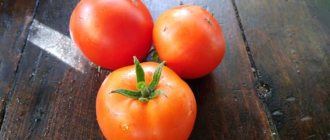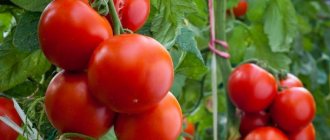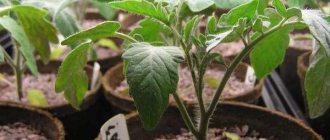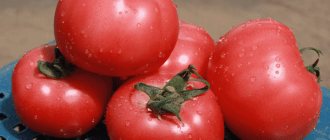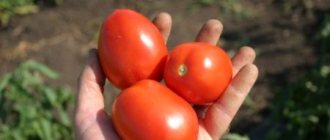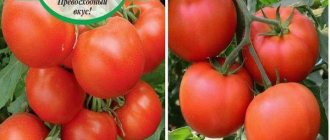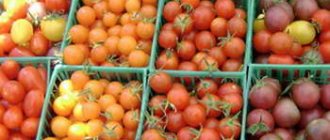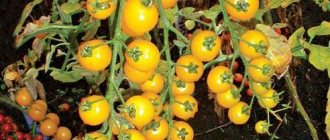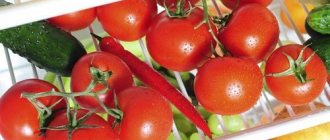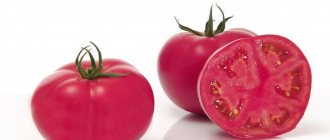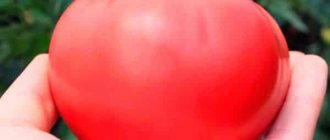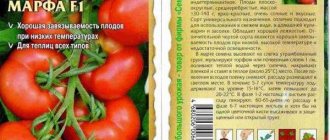Tomato Ritchie F1 is universal. It can be grown by summer residents, owners of small household plots and large farmers. The hybrid grows even in areas where tomato culture is poorly developed due to the cold climate and short summer.
| Height | Landing location | Ripening time | Fruit color | Fruit size | Origin | Fruit shape |
| Medium height | Open ground | Early ripening | Reds | Average | Hybrid | Round |
Ritchie tomatoes: variety description
| Variety name | Richie |
| general description | Early ripening, determinate variety of tomatoes |
| Originator | Holland |
| Ripening period | 80-95 days |
| Form | Rounded |
| Color | Red |
| Average weight of tomatoes | 90-120 grams |
| Application | Universal, good for whole fruit canning |
| Productivity of the variety | 1-1.5 kg per bush |
| Features of cultivation | Requires shaping and tying |
| Disease resistance | Resistant to major tomato diseases |
Tomato "Richie" f1, description of the variety: this is a very early ripening tomato, 80-95 days pass from planting seedlings to the first fruits. The plant is short, 50-70 cm . The type of bush is standard, determinate. Read about indeterminate varieties in this article. “Richie” is recommended for growing in greenhouses, hotbeds and under film, but it also grows successfully in open ground; some try to grow it on the balconies of city apartments. This tomato has a very high degree of protection against fungal diseases. Has F1 hybrids of the same name .
Ripe fruits are red and round in shape. Small tomatoes from 90 to 120 g . The number of chambers is 2-3, the dry matter content is approximately 5%. The collected fruits can be stored for a very long time and tolerate long-distance transportation well. For these qualities, they are loved not only by summer residents, but also by farmers.
You can compare the weight of tomatoes of this variety with others in the table below:
| Variety name | Fruit weight (grams) |
| Richie | 90-120 |
| Russian size | 650-2000 |
| Andromeda | 70-300 |
| Grandma's gift | 180-220 |
| Gulliver | 200-800 |
| American ribbed | 300-600 |
| Nastenka | 150-200 |
| Yusupovsky | 500-600 |
| Dubrava | 60-105 |
| Grapefruit | 600-1000 |
| Golden Jubilee | 150-200 |
Bush care
"Richie F1" is a low-growing determinate plant. There is no need to garter or support the bush, and shaping is carried out only in the greenhouse. Therefore, the agricultural technology for growing it comes down to basic measures:
- Watering. The volume of watering is selected individually for a specific climate zone. The soil should be moistened to a depth of 25-30 cm, and water should not stand on the bed;
- Loosening. In cool weather, the bed is loosened at least once every 5 days, during drought - no more than once a week. It is advisable to carry out loosening between waterings to prevent the formation of an earthen crust;
- Formation. In a greenhouse, bushes are formed into 3-4 stems, on a balcony - 1-2 stems. Stepchildren are cut off when they grow 4-5 cm, leaving “stumps” of 2 cm;
- Feeding. Root fertilization is carried out every 2 weeks, alternating organic matter and mineral complexes (mullein and superphosphate).
Characteristics
Hybrid tomatoes "Richie" are very well suited for whole-fruit canning. It will perfectly complement any dish with its taste. They also make very tasty and healthy juice; lecho and purees are also very good.
Under good greenhouse conditions, this species yields 1-1.5 kg per bush, with a planting density of 7-8 plants per square meter, this yields up to 10 kg; in open ground the yield is slightly lower. This is a very modest figure.
You can compare the yield of Ritchie with other varieties in the table below:
| Variety name | Productivity |
| Richie | 1-1.5 kg per bush |
| De Barao the giant | 20-22 kg per bush |
| Polbig | 4 kg per square meter |
| Sweet bunch | 2.5-3.2 kg per square meter |
| Red bunch | 10 kg per bush |
| Summer resident | 4 kg per bush |
| Fat Jack | 5-6 kg per bush |
| Pink Lady | 25 kg per square meter |
| Countryman | 18 kg per bush |
| Dad | 6 kg per bush |
| Golden Jubilee | 15-20 kg per square meter |
Preparing seedlings
The Tolstoy F1 variety is a hybrid, so collecting seeds for planting on your own is not practical. They can be purchased annually at a specialty store.
In February-March it is necessary to start planting tomato seeds. The soil is prepared in advance. The earth is mixed with sand and wood ash or humus. Before planting seeds, the soil must be disinfected by calcination in the oven or using a weak solution of manganese.
Seeds purchased in a store have already been treated for pests, so pre-soaking is not required. The seeds should be planted shallowly in the ground - 1-1.5 centimeters. Next, you need to moisten the soil using a spray bottle, after which greenhouse conditions are created. The ground is covered with glass or film.
After the first shoots have appeared, the greenhouse is opened and the seedlings are placed in a warm place.
The tallness of this tomato variety is unlimited, and in insufficient light the plant will grow very tall.
For uniform growth of seedlings, it is necessary to maintain a certain air temperature. At night in the room where the seedlings are standing, it should be +10 degrees, and during the day +15 degrees.
After two leaves appear, it is necessary to pick. This stimulates the growth of plant roots.
After thirty days from planting the seeds, it is necessary to fertilize the seedlings. Two weeks before planting seedlings in the ground or greenhouse, they need to be hardened off. To do this, take the seedlings out into the fresh air every day or simply ventilate the room.
All about proper cultivation of tomatoes in a greenhouse
Advantages and disadvantages
The advantages of the Richie tomato variety include its keeping quality and transportability, which are very high. As well as disease resistance and early ripening. Some lovers note that it can be grown on the balcony.
The main advantages of a “guest from Holland” include:
- early ripeness;
- the ability to grow at home;
- high immunity;
- good taste.
The disadvantages include not very high yields and capriciousness to external conditions, such as temperature, watering and fertilizing.
Features of cultivation
Although the bush is not tall, it is better to tie it up and strengthen the branches with supports. It should be formed into three or four stems, if grown on the balcony, then two. This variety is quite demanding regarding watering and lighting conditions.
It responds very well to complex feeding at all stages of growth.
Read all about fertilizers for tomatoes on our website:
- Organic, mineral, phosphorus, ready-made, TOP of the best.
- Yeast, iodine, ash, ammonia, hydrogen peroxide, boric acid.
- For seedlings, foliar, when picking.
You should also pay attention to the fact that tomato grows better in neutral soils; in acidic soils it may lose yield. On our website you will find a series of articles on this topic. Read about what types of soil for tomatoes exist, which soil is more suitable for seedlings and which for adult plants in greenhouses, how to make your own soil mixture, how to prepare soil in a greenhouse for spring planting.
